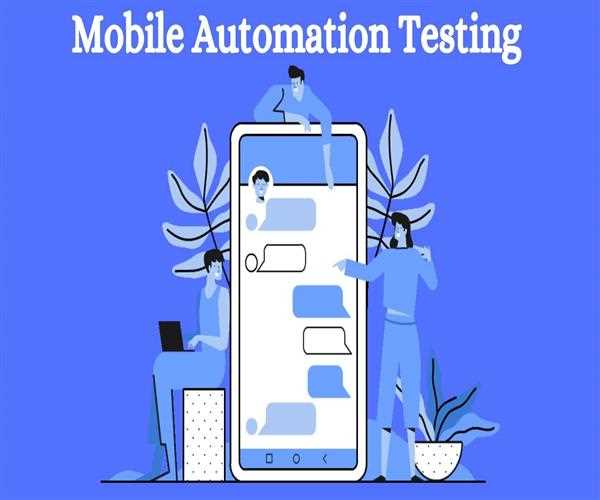What is mobile automation testing?
Mobile automation testing is the process of testing a mobile application on mobile devices using an automation tool to find the defects. Mobile automation testing is similar to web app testing.
Automating mobile apps is absolutely necessary for today's huge market of smartphones, tablets, and other mobile devices because there are so many types of mobile devices available nowadays. To test the application on all these types of devices and platforms is very difficult, time-consuming, costly, and can not be done manually.
Mobile automation testing helps you to automate some repetitive and monotonous tasks, test complex workflows that span multiple screens, and perform large-scale regression testing with ease.
Why Should You Automate Testing Mobile App Testing?
Automating testing mobile apps is crucial to speeding up testing and expanding test coverage, on both devices and in test situations. Mobile automation for apps is notoriously difficult however, the majority of test scenarios can be successfully automated.
Automate wisely How to Begin:
If done improperly Automation can fail and is time-consuming, it's difficult to install. It is important to avoid this in order to gain the most return on investment from your automation as can.
If you plan your test strategically, there are a variety of advantages to testing automation that you can reap. This includes faster feedback, quicker bug detection better protection against risk, wider coverage of tests, and a faster time to publish.
If you're only beginning to get started with mobile automation testing It is advised to begin with a small amount. Do not try to automate everything in one go. In reality, you won't ever automate all of your tests.
How do you get started?
If you're testing mobile apps it is recommended you begin automating three distinct kinds of test cases which include Integration tests and unit tests as well as functional tests. They should form your top priority for automating and are a great start for anyone starting out.
The Top 5 Tests for Automating:
1. Unit Testing
Tests using unit testing are the quickest technique of testing. They are extremely reusable and are also simpler to troubleshoot, generally at a lower cost of fixing.
2. Integration Testing
Testing integration ensures that everything functions as expected for interfaces and modules. Automating these tests can be beneficial since it reduces the testing process and also provides rapid feedback.
3. Functional Testing
Functional testing is a different type of test that should be considered prioritized to automate. Automation of functional UI tests will help you evaluate the performance of your app across OSes, devices as well as other variations. Since the mobile ecosystem is extremely dispersed, this is extremely crucial.
Tips and Best Techniques for Automated Mobile App Testing:
Here are some good techniques that engineers should consider when considering automated mobile application testing:
Test the application:
In the present day of agile development, developers must create applications that are tested and ready to go. Developers must be actively discussing with the testing teams to establish guidelines. For instance, developers must provide elements with a unique ID that makes them possible to test.
Be careful not to use the XPath:
XPath is an XML query language that allows you to choose nodes within the XML file. It is a tool to navigate across elements during conducting tests. Google or Apple doesn't natively support XPath types of questions. Therefore, if test users are using these queries frequently, Appium is forced to make calls. These under-the-hood calls are able to locate XPath elements that are supporting them but adversely affect the performance.
Arrange the Selectors in the Right Placement:
XPath is location-based. It's slow in comparison to other selenium locators like ID or Link Text or Name. Sort the selectors in such order that ID is the first one and XPath is the last one, in order to make it easier to find elements faster.
Utilize Accessibility IDs:
Instead of a lot of use of XPath testers could utilize access ID locators. When users add accessibility IDs on their components this makes them easier to test and broadens the testability of their applications.
Examine the View states of the Application:
View states are a method that stores the value of the page whenever the application transmits or receives data via the servers. Let's say you have 15 test cases to test the specific functions for the app. All 10 test cases are re-creating the same function of logging in and then going to the website. This is a massive time waster. When developing, you must set up the state of view for the application in such a way that testing can begin exactly when it is needed.
Do not compromise on Emulators and Simulators:
Emulators and Simulators can partially replicate real devices partially. While they can be useful for testing during the initial stages of developing apps but they're not a great fit for simulating actual user scenarios. For example, the Android simulator can't replicate low battery levels or the 2G connection even when your computer is on 4G. If apps are not tested under less than ideal conditions, they are not released. If an app is only tested using emulators and simulators can result in disappointing, and sometimes even negative user experience.
It's far more effective to test mobile applications on an actual device cloud. BrowserStack offers hundreds of smartphones (iOS, Android, Windows) to QAs in order to evaluate their applications. Testers have access to native device features as well as an array of useful features like geolocation testing, for instance, and a throttler for networks. BrowserStack also integrates to mobile test frameworks, such as Appium, EarlGrey, and XCUITest to make it easier to conduct rapid, efficient, and results-oriented testing.




Leave Comment